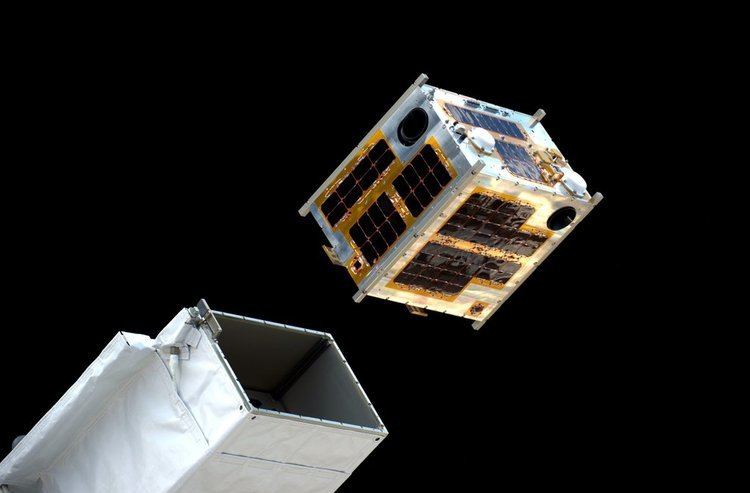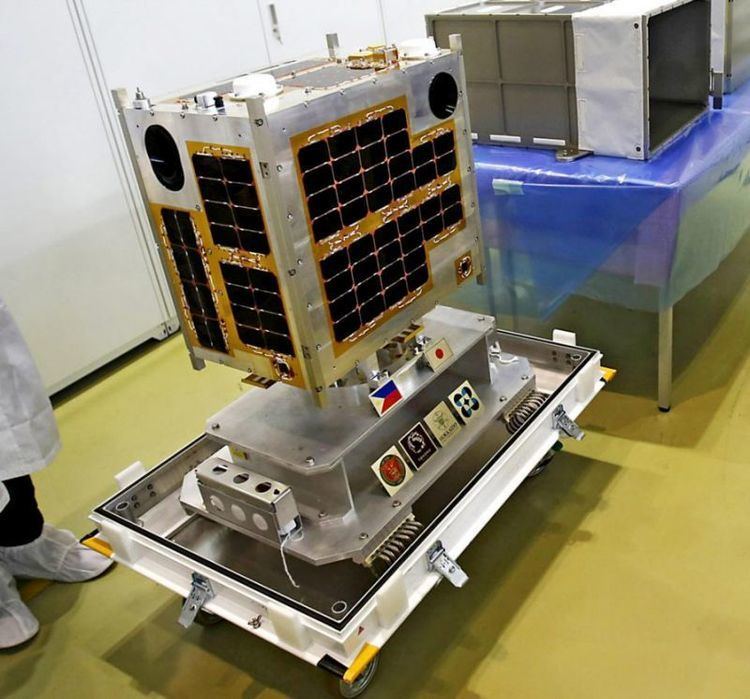BOL mass 50 kg (110 lb) Launch site Cape Canaveral SLC-41 Launch date 2016 Inclination 51.6° | Dimensions 55 cm x 35 cm x 55 cm Inclination 51.6° | |
 | ||
Mission type Earth observation satellite Similar Cygnus, e‑st@r‑II, Progress MS‑02, Alsat‑1B, Swayam | ||
First philippine microsatellite diwata 1 launched
Diwata-1 also known as PHL-Microsat-1 is a Philippine microsatellite launched to the International Space Station (ISS) in March 23, 2016, and was deployed into orbit from the ISS in April 27, 2016. It is the first Philippine microsatellite and the first satellite built and designed by Filipinos.
Contents
- First philippine microsatellite diwata 1 launched
- Replay orbital atk cygnus launch coverage diwata 1 march 23 2016
- Background
- Etymology
- Development
- Instruments
- Launch from Cape Canaveral
- Deployment into orbit from the ISS
- Operation
- Impact
- References

Replay orbital atk cygnus launch coverage diwata 1 march 23 2016
Background

Hokkaido University and Tohoku University of Japan initiated a project to send 50 microsatellites into space by 2050. The project will photograph aftermaths of natural disasters, partnering with governments, universities and other organizations based in Bangladesh, Indonesia, Malaysia, Myanmar, Mongolia, Philippines, Thailand, and Vietnam. Two satellites are commissioned for the Philippine government.
Diwata-1 is the first satellite of the venture and is also a part of the Department of Science and Technology's Philippine Scientific Earth Observation Micro-Satellite (PHL-Microsat) Program which was initiated in December 2014 by the government agency. The satellite is an updated version of the Raijin-2, which was developed by the two Japanese universities.

There were two Philippine satellites before Diwata-1, Agila-1 and Agila-2 (later renamed ABS-3) but the former was owned and operated by a non-Philippine firm, PT Pasifik Satelit Nusantara, at the time of its launch and the latter was owned by Mabuhay, private local firm but later acquired by Asia Broadcast Satellite, a foreign firm.

The government has been availing services from foreign countries for satellite imagery. Carlos Primo David, executive director of the Philippine Council for Industry, Energy and Emerging Technology Research and Development (PCIEERD) called the PHL-Microsat program a "small investment" taking note that in 2013, following the aftermath of Typhoon Haiyan (locally known as Typhoon Yolanda), the government had to pay about ₱56 million for satellite imagery of an area affected by the typhoon dubbed as the "Yolanda Corridor". This led to the creation of the PHL-Microsat program.
Etymology
The satellite was named after a type of being from Philippine mythology, the diwata.
Development

A team of nine Filipino engineers from the DOST-Advanced Science and Technology Institute (ASTI) and the University of the Philippines, dubbed the "Magnificent 9", were responsible for the production of Diwata-1 and collaborated with scientists and engineers from the two Japanese universities. They were sent to Japan in October 2015. The second (unnamed) microsatellite will be developed later. Assembly and testing of Diwata-1 was completed in December 2015.
Diwata-1 was handed over to the Japan Aerospace Exploration Agency (JAXA) on January 13, 2016, at the Tsukuba Space Center in Tsukuba, Japan. On January 18, 2016, JAXA sent the satellite to the National Aeronautics and Space Administration (NASA), in the United States, after conducting final tests on the satellite.
Component tests, first vibration tests, post-vibration electrical tests, off-gas test, and fit checking were conducted on the satellite. Continuous functionality test of modules and sensors and software optimization were also done on the satellite.
Instruments
DIWATA-1 has three scientific instruments: the High Precision Telescope (HPT); Space-borne Multispectral Imager (SMI) with Liquid Crystal Tunable Filter (LCTF); and the Wide Field Camera (WFC). DIWATA-1 also has one engineering control instrument, the Middle Field Camera (MFC).
The HPT – with a ground sample distance (GSD) of 3 metres (9.8 ft) at 400 kilometres (250 mi) – is currently being studied on how it can be used to monitor the extent of damages from natural disasters such as typhoons. It is also equipped with four CCDs for the red, blue, green, and near infrared regions of light.
The SMI with LCTF – with a GSD of 80 metres (260 ft) at 400 kilometres (250 mi) – is currently being studied on how it can be used in measuring vegetation changes and phytoplankton biomass in Philippine waters. The instrument is equipped with two CCDs for both visible (420–700 nm) and near infrared (650–1050 nm) regions with a 13 nm interval.
The WFC – which has a GSD of 7 kilometres (4.3 mi) and a panchromatic CCD with a field view of 1800 × 1340 – is used to give visualizations of large-scale cloud patterns and distributions. DIWATA-1 can be used to take daily images using the WFC in case any upcoming large-scale weather disturbances such as storms or typhoons.
The calibration of the attitude determination algorithm will be handled by the MFC. The instrument is equipped with a colored CCD and expected GSD of 185 metres (607 ft) and will also aid in locating images captured by the HPT and SMI.
Launch from Cape Canaveral
The launch of Diwata-1 occurred on March 23, 2016, at Cape Canaveral, Florida in the United States. It was a payload of Orbital ATK's Cygnus spacecraft which was launched through the Atlas V rocket as part of a supply mission to the International Space Station (ISS). Initially the plan was reportedly to launch Diwata-1 through a vehicle by SpaceX, from either California or Florida to the ISS. Earlier, an orbital slot was secured from JAXA for Diwata-1. Cygnus managed to reach the ISS in March 26. The spacecraft unloaded its cargo, including Diwata-1, to the ISS in the span of two weeks.
Deployment into orbit from the ISS
Diwata-1 was set to be deployed from the International Space Station from the Kibo module. The satellite was inspected on board the station before its deployment in April for at least 18 months of program activity. The deployment mechanism for the satellite was the JEM Small Satellite Orbital Deployer (J-SSOD).
By January 2016, the Kibo module had already deployed 106 small satellites. The Diwata-1 deployment marked the first attempt of the module to deploy a smaller, 50-kg class, microsatellite. The deployment of Diwata-1 was scheduled on April 20 or 21, 2016. Prior to the Cygnus launch, The DOST has made a request to JAXA to deploy the satellite into space between March 21 and April 30, 2016, at the time the ISS is at its highest altitude. The deployment was later announced to take place in April 27, 7:00 p.m (PST). The actual deployment occur at 7:45 p.m. with British astronaut, Tim Peake personally involved in the operation to put the satellite into orbit.
In occasion of the deployment, the Philippine flag was raised along with the Japanese flag at the Tsukuba Space Center of the JAXA.
Operation
The mission duration of the satellite is expected to take place for around 20 months, 2 months longer than earlier reported. The engineering team behind Diwata-1 at the Tohoku University was able to receive the satellite's first communication hours later after its deployment from the ISS, at 7:45 p.m. PST.
A ground station based in the Philippines, the Philippine Earth Data Resources Observation (PEDRO) Center, will have primary control over the satellite with a command line on the UHF band. PEDRO will receive telemetry data sent by Diwata-1 via UHF band and receive images via X-band. The Tohoku University Ground station (CRESST) will also have access to the satellite.
Weeks into the satellite's deployment since the Cygnus launch, the setting up of a temporary ground receiving station at the DOST ASTI building is being hastened by DOST units, PCIEERD and Advanced Science and Technology Institute. Diwata-1 is set to be operational at least a week after its deployment into orbit.
The satellite's first images were released in public by the Tohoku University on June 2, 2016, via a Japanese press release. The satellite shot images of Isabela province, the island of Luzon and parts of Northern Japan.It has also captured images of the coastlines of Palawan, showing signs of siltation on certain parts of the coastline.
Impact
One of the major goals of the PHL-Microsat program, to which Diwata-1 belongs, is to boost the progress on the creation of the Philippine Space Agency. DOST secretary Mario Montejo said that the Diwata-1 endeavour may pave the way for development of the local electronics and aerospace industries which would complement a satellite-building industry.
The University of the Philippines Diliman campus has allocated an area for a space research laboratory for the continued development of microsatellite technology, where the Filipino scientists were involved in the Diwata-1 project can teach and train local engineers. The facility will be funded by the Philippine Council for Industry, Energy and Emerging Technology Research and Development of the DOST.
